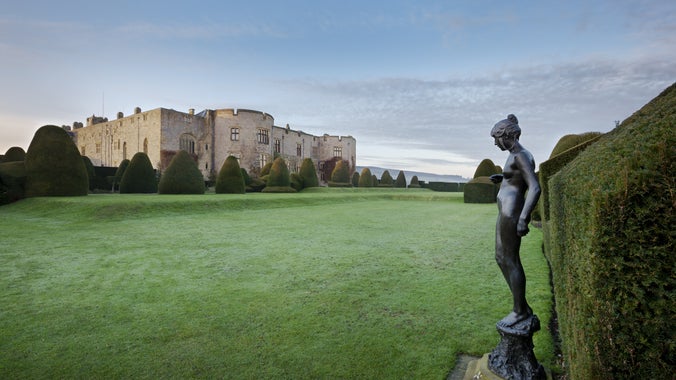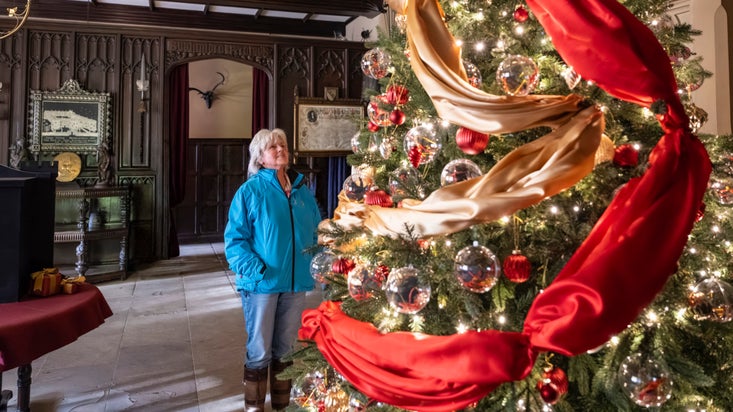
Become a member
Join today and help protect nature, beauty and history – for everyone, for ever. Enjoy access to more than 500 places with National Trust membership.
Magnificent medieval fortress of the Welsh Marches
Chirk Castle, Chirk, Wrexham, LL14 5AF

| Asset | Opening time |
|---|---|
| Castle | 11:00 - 16:00 |
| Garden | 10:00 - 16:00 |
| Tower | 10:00 - 16:00 |
| Shop | 10:00 - 16:00 |
| Café | 10:00 - 16:00 |
Second hand bookshop at Home Farm by car park.
Cafe located in Castle Courtyard.
Dogs are allowed on the estate and, on a short lead only, in the formal gardens and Pleasure Ground Wood, but are not allowed in the kitchen garden or play area. Assistance dogs only inside the castle rooms.
Guided morning tours when volunteers are available.
Plants available from main shop
Shop at Home Farm by ticket office.
Toilets, including accessible toilets, at Home Farm and in the castle courtyard.
Unfortunately there is no wheelchair or step free access to the castle interior. We welcome all registered assistance dogs. The shuttlebus helps visitors up to the castle and runs throughout the day. This is a volunteer-run service and may not be available every day, please check before visiting.
Accessible route in the garden.
Accessible toilets are available at Home Farm (RH-transfer) and in the castle courtyard (LH-transfer).
A Braille guide to the property is available from the castle entrance, please ask you or one of your party would like to use this.
Induction loops in the ticket office, shop and cafe, and for guided tours.
We have one electric Tramper which is capable of exploring the gardens and estate. To reserve this please contact us.
Virtual tour on an iPad available at entrance to furnished rooms.
Car park - what3words: ///acting.diagram.cavalier
The 480-acre estate can be a great place to explore with your pooch whatever the weather. Find out more about where you can take your dog and where you can stop for a tasty treat.

Explore medieval history and more, with group and school visits to Chirk Castle in Wales.

A 13th-century Marcher castle, that from 1595 became the home of the Myddelton family for over 400 years.
5.5 acres of award-winning garden, including manicured lawns, clipped yews, and stunning views over the Cheshire and Shropshire plains.
480 acres of working parkland and important nature habitats, featuring ancient veteran trees, wildflower meadows and part of Offa’s Dyke.
A predominately 18th-century model farm, with stable and threshing barn, that now houses our ticket office, shop, bookshop and visitor facilities.
Located in the castle’s historic kitchens, the café serves hot and cold drinks, snacks, cream teas and light meals.
Situated at Home Farm, the dairy offers snacks and drinks, on busier days. When the weather allows, there is a small seating area available.
Located at Home Farm, the shop sells gifts, plants, garden decorations and tools, toys and local food products. We also have a second-hand bookshop.
One play area at Home Farm with natural wooden equipment.
There's lots of fun to be had at Chirk Castle to keep little ones running, playing and learning no matter what time of year.

Chirk Castle was never planned as a family home. It was one of several medieval Marcher fortresses along the Welsh-English border, built to keep the Welsh under English rule.

Indulge your senses and refresh your spirit with a gentle wander amongst the scents and seasonal colours of the rare shrubs and flowers in this lovely five-and-a-half acre garden.

Take a walk around Chirk's fascinating 480-acre parkland, and discover a working landscape full of ancient trees, wild flowers, birds and bugs.

This Christmas, make magical memories as you explore Chirk Castle. Discover playful shadow puppet theatres and beautiful rooms, with decorations inspired by the castle’s rich history - from its origins as a 13th-century medieval fortress to its transformation into a grand family home for the Myddeltons.

This trail takes you around Chirk Castle's lovely 5.5 acre garden and is accessible for wheelchairs and pushchairs.

An easy circular walk among the woodlands and open fields surrounding Chirk Castle in Wrexham, Wales.

A 3-mile circular walk from Chirk Castle, taking in a small section of Offa's Dyke path and passing the site of the Battle of Crogen.

This moderate 1.2-mile walk takes you up onto an area known as the Old Golf, with a memorable view of Chirk Castle halfway around.

This gentle mile-long walk through 18th-century designed parkland at Chirk Castle offers memorable views towards the Cheshire and Shropshire plains.

Visit our tea-room and enjoy homemade cakes that are baked daily, using the freshest ingredients. Or visit the gift shop which is packed with handmade treats and souvenirs.


At the top of Offa’s Dyke this 1930s villa is in a great spot for exploring nearby Chirk Castle.

Explore the grounds of a 700 year-old castle when you stay in this traditional Welsh cottage.

Close to Chirk Castle with walking trails all around, this pretty stone cottage has an enclosed garden.

This gorgeous half-timbered cottage in the stunning Powis Castle gardens has gorgeous Edwardian interiors.
This festive season make magical memories as you journey through over 700 years of history at Chirk Castle and Garden.
A stark symbol of power, the construction of Chirk Castle began around 1295 during the reign of the conquering Edward I in order to subdue the last princes of Wales. Built on an outcrop above the meeting point of the Rivers Dee and Ceiriog, the castle, with its imposing silhouette, was a brooding statement of English intent in these disputed lands. Chirk Castle was purchased by grocer, sugar trader and privateer Sir Thomas Myddelton in 1595, and was inherited through the Myddelton family line. With over 700 years of history, and as the last castle from this period still lived in today, Chirk Castle has lavish interiors and a beautiful and eclectic collection. The interior includes a 17th-century Long Gallery, grand parade of three 18th-century State Rooms with rich furniture, paintings and tapestries, the unique servants' hall, and the Chapel Music room furnished to display Chirk Castle’s connections to high society in the 1920s and 1930s. The award-winning gardens cover 5.5 acres of manicured lawns, clipped yews, herbaceous borders, beautiful rose, shrub and rock gardens, and the wooded pleasure ground – perfect for a stroll. Don't miss the terrace overlooking the 18th-century ha-ha at the bottom of the garden, with stunning views over the Cheshire and Salop plains. Chirk Castle has over 480 acres of estate parkland for you to explore, with sheep, cattle, veteran trees, wildflower meadows and a beautifully preserved section of Offa’s Dyke. The estate is located within an Area of Outstanding Natural Beauty and has also been designated a Site of Special Scientific Interest as an important habitat for rare invertebrates, bats, fungi, and wild flowers.
Chirk Castle was never planned as a family home. It was one of several medieval Marcher fortresses along the Welsh-English border, built to keep the Welsh under English rule.

Living in a castle for 400 years a family gathers a diverse collection of art, furniture and curiosities. Here’s some of the treasures in Chirk’s collection.

Join our great team of volunteers at Chirk Castle in Wales.

Chirk Castle are delighted to have received a grant from Cadwyn Clwyd to create a Mindful Meadow at Chirk Castle working in partnership with local groups to contribute to its design and creation.
A rare full-length, life-size portrait of a servant at the National Trust’s Chirk Castle in Wrexham has gone on display following conservation and research to reveal some remarkable clues about his background.

0.65 hectares of SSSI (Site of Special Scientific Interest) at Chirk Castle has been improved for people and nature as National Trust Cymru team up with a range of organisations and local charities to create a new Mindful Meadow, where people can connect to nature, improving their health and wellbeing.

An exquisite portrait of Lady Margaret Myddelton and a portrait of Robert Myddelton-Biddulph which were both previously at Chirk, go on display for the first time. The portraits were gifted by the late Lady Aird, daughter of Lady Margaret Myddelton.

We have purchased collections belonging to the Myddelton family and spanning over four hundred years of their time at Chirk Castle. Around three hundred historically important items have been transferred to our care, where they will remain forever, for everyone’s enjoyment.

Three generations of the Williams family come together to plant a rare sapling at Chirk Castle, a sapling grafted from the Pontfadog Oak which stood during Owain Gwynedd’s defeat of the English and featured in the Guinness Book of Records as the ‘widest tree in Great Britain’.


Join today and help protect nature, beauty and history – for everyone, for ever. Enjoy access to more than 500 places with National Trust membership.
By sharing your email address you’re agreeing to receive marketing emails from the National Trust and confirm you’re 18 years old or over. Please see our for more information on how we look after your personal data.